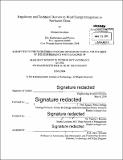Regulatory and technical barriers to wind energy integration in northeast China
Author(s)
Davidson, Michael (Michael Roy)
DownloadFull printable version (10.94Mb)
Other Contributors
Massachusetts Institute of Technology. Technology and Policy Program.
Advisor
Ignacio Perez-Arriaga and Valerie J. Karplus.
Terms of use
Metadata
Show full item recordAbstract
China leads the world in installed wind capacity, which forms an integral part of its long-term goals to reduce the environmental impacts of the electricity sector. This primarily centrally-managed wind policy has concentrated wind development in a handful of regions, challenging regulatory frameworks and grid architectures to cost-effectively integrate wind. In 2013, according to official statistics, wind accounted for 2.7% of national generation, while the rate of curtailment (available wind not accepted by the grid operator onto the system) reached 12%. Wind integration challenges have arisen in China for technical, economic and institutional reasons. From a technology standpoint, the variability and unpredictability of wind resources interact with technical limits of conventional generators, resulting in efficiency losses and grid stability concerns. Existing coal-based electricity and district heating installations play a large role in grid integration challenges because of the inflexible operation of coal plants relative to natural gas and hydropower, and the "must-run" nature of cogeneration units supplying residential heat. A competing set of hypotheses to explain current rates of wind spillage focus on institutional imperfections in China's power sector, such as poorly designed market incentives, inadequate oversight, and a mixture of conflicting policies that are the result of an incomplete transition to a market-driven electricity system. A unit commitment and dispatch optimization was developed to understand the underlying technical factors leading to wind curtailment in northeastern China. It incorporates electricity output restrictions from exogenous district heating demands, a hydro-thermal coordination component considering inter-seasonal storage, and transmission between adjacent provincial nodes. Averaging over six historic wind profiles, a curtailment rate of 6.6% was observed in the reference case from various forms of inflexibility and insufficient demand. The impacts of several technology-based solutions on total cost, coal use and wind curtailment, were also examined: more flexible operation of coal units, temporary heat storage and minimum cogeneration outputs that vary with heat load. Contributing to the existing body of qualitative work on the effects of these factors, this thesis developed a straightforward methodology to assess the relative contribution of regulatory and technical causes. Two important institutional arrangements - the decentralization of dispatch to individual provinces and minimum generation quotas allocated to all coal generators - were quantified in an optimization framework, and found to be significant contributors of power system operational inflexibility.
Description
Thesis: S.M. in Technology and Policy, Massachusetts Institute of Technology, Engineering Systems Division, Technology and Policy Program, 2014. 111 Cataloged from PDF version of thesis. Includes bibliographical references (pages 68-73).
Date issued
2014Department
Massachusetts Institute of Technology. Engineering Systems Division; Technology and Policy ProgramPublisher
Massachusetts Institute of Technology
Keywords
Engineering Systems Division., Technology and Policy Program.